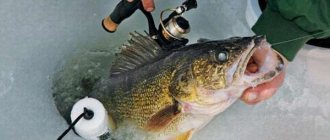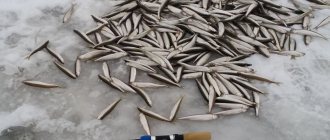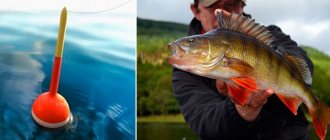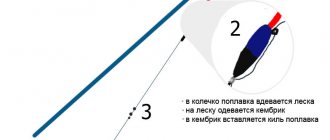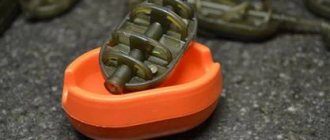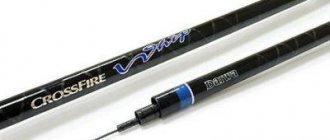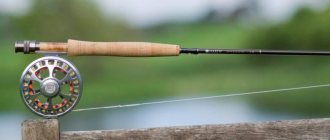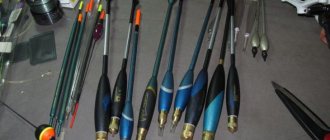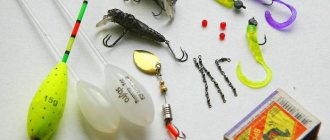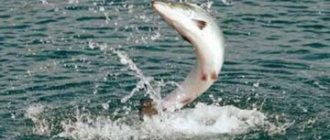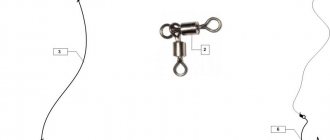Home > Winter fishing > Catching smelt in winter - secrets, tackle, bait
In the waters of the Gulf of Finland, the Baltic Sea, and the Far East, ice fishing for smelt is very common among fishermen. Despite its small size - the average length is 100-200 mm (rarely up to 300) - this fish is in great demand due to its active bite and very high taste. And most importantly, winter smelt fishing is very simple and accessible to absolutely any angler.
Where to look for smelt
With the onset of winter cold, smelt begins to prepare for spawning, which will begin in the second half of winter. At the same time, it gathers into huge shoals and moves closer to the shore, to the confluence of rivers, where the water is more desalinated. To search for smelt under the ice, you can select the following places: • river mouths; • areas with a flat bottom; • absence of too great depths. Most often, smelt are caught at a depth of up to 8 meters, but sometimes there are exceptions and in some places the fishing depth can reach 15-20 meters. You can determine the location of a school of fish by the large number of fishermen. As a rule, during the period of active biting, dozens and hundreds of fishermen sit next to each other, while there is practically no competition or unevenness of the bite. However, even if there are no fishermen and it is difficult to decide on a catchable place, you can safely go to the mouth of the river - the smelt will be there in any case.
Features of the scarf
The scarf is quite a useful and convenient tackle for fishing enthusiasts due to its features:
- It has the shape of a triangle, thanks to which it easily fits into the hole;
- Easy to use, to catch fish you just need to attach it to a rope;
- Easily removed from under the ice.
The design does not have a float and is intended only for ice fishing. However, it is not possible to fish with it throughout the entire winter period; in severe frosts it will not bring any catch.
Let's celebrate!
It is best to use the device at the beginning of the winter, when the ice is just getting stronger; at this time, the fish are looking for a parking place, so they gather in schools.
Description of the scarf
This type of gear consists of:
- Metal frame;
- Canvases mainly use a mesh with small-sized cells;
- At the top of the structure there is a ring, behind which the scarf is attached to the rope.
The frame of the device most often consists of a metal rod, which simultaneously serves as a sinker, with the help of which the structure is lowered under the water to the very bottom.
Note!
The size of the cells on the grid is selected individually. If you plan to catch small fish, then the dimensions should be no more than 20 mm. If fishing tackle is used for fish that will go to the fish soup, then the mesh size must be at least 50 mm.
The principle of fishing with a scarf
Fishing with this type of structure is quite simple. To do this, fishing tackle is lowered into the prepared hole, always with the sinker down so that it is at the bottom. After this, the fish are fed with special food, which uses ready-made mixtures with plant or animal additives. Rusks, swollen grains, cake or maggots are often used as additives.
In different winter periods, the device is lowered to different depths. At the very beginning of winter, when the ice has just hardened, the fishing gear is lowered closer to the ice surface. This is done because the fish is quite active and has not sunk to the bottom.
The same is done at the end of the winter period, when the air temperature becomes significantly higher, this is explained by the fact that the fish rise closer to the ice surface due to the large amount of oxygen in the water.
In the middle of winter, it is practically not used, since the fish sinks to the very bottom, buries itself in the silt, where it finds food for itself and does not freeze. Therefore, the fish is not interested in complementary feeding, and it will not come up for it. In severe frosts, fishing with a scarf is useless; there will be no catch, since the fish will not come out for food.
Note!
After the fisherman feeds the fish, a scarf is placed in the hole. It must be left for a certain period of time, and then checked. This type of fishing tackle allows a fishing enthusiast to fish not only with it, but also to use a fishing rod at the same time. In this case, the catch will be larger and richer, just don’t forget to check the scarf periodically.
Preparing gear
Catching smelt in winter does not require any specific gear. The equipment is also quite simple and easy to make yourself. Depending on the chosen fishing method, the set of gear elements may differ: 1. Any rod for winter fishing will be suitable as a fishing rod. 2. You can install a reel, but many people do without it. 3. The main fishing line is monofilament intended for winter conditions, with a thickness of 0.08 to 0.25 mm. The diameter depends on further equipment and fishing conditions. 4. Lead line, the thickness of which is slightly less than the diameter of the main one. 5. When installing the nod, use a signaling device made of a metal spring, the length of which is 8-10 cm. 6. Hooks, jigs or spinners. At different periods of winter, smelt may prefer different baits. Therefore, anglers often prepare several rigs in advance and take various baits with them. 7. A weight of any shape at the discretion of the fisherman. The weight depends on the depth of fishing and the presence of current. 8. Float.
Smelt: description of fish
- It is classified as a salmon.
- The fish is small, with medium-sized silvery scales.
- The abdomen is white-yellow, the back is greenish with a blue tint.
- It is a largemouth fish. She has sharp teeth not only in her mouth, but also on her tongue.
- She is a predator. It feeds on various crustaceans, caviar, small fish, and insect larvae.
- The weight of the fish reaches 350 g, body length up to 40 cm.
- Despite its small size, it is unpretentious in food, so it is successfully bred by humans on fish farms.
It prefers to spend a significant part of its life cycle in coastal waters. With the beginning of winter, fish accumulate in the lower reaches of rivers until spawning. The migration route during the spawning period can reach thousands of kilometers and depends on where exactly the fish lives.
Fishing methods
The choice of method for catching smelt from ice can be influenced by weather conditions, angler preference, and fish activity. Despite the fairly high biting activity, in some periods the smelt may refuse the offered bait and the fisherman has to adapt to its preferences. Smelt is mainly caught by fishing with a tyrant, a nodding rod and a float.
Fishing with a tyrant
Samodur is a very simple and popular equipment for catching smelt. It shows itself especially well in the first half of winter, especially after freeze-up, when the pre-spawning feast forces the predatory smelt to rush to almost any bait.
It is very easy to make this equipment:
• Take a piece of lead line 1.5-2 meters long. The size of the segment can vary and depends on what horizons the angler wants to fish. • A weight is tied to the end of the fishing line. • Above the sinker, at a distance of 10 cm, a short leash with a hook is tied. Next, several more hooks are knitted at an equal distance from each other. They need to be tied so that their stings point up in the water. • All equipment is tied to the main line.
The number of hooks may vary and range from 3 to 15 pieces. Since smelt can occupy not only the bottom layers, and a large number of hooks allows you to find fish at different depths. At the same time, the more hooks, the more difficult it is to handle the tackle and the likelihood of entanglement increases significantly. With a good bite, three hooks are enough.
The hook size is usually small - No. 2.5-3.5 according to the domestic size chart. But often anglers use larger hooks, especially if there is a large fish. The diameter of the main line ranges from 0.12-0.16 mm, for leashes - 0.08-0.10 mm. The tyrant rig is tied to the main fishing line. Fishing takes place with a regular nodless winter fishing rod.
Operating principle and features of use:
• Pieces of colored latex (green, red) 4-6 mm in size are used as bait or hooks are tied with multi-colored threads or hairs. Special latex strips can be bought at a fishing store, but quite often fishermen cut pieces of the desired size from a regular condom. • The equipment is immersed in the hole until the weight touches the bottom. He should pull the line, holding it in one place. • Fishing is passive, but if the bite is bad, you can periodically twitch the tackle. They set up several fishing rods at the same time, going around them one by one and checking for the presence of prey. • If the fish activity is weak, you can loosen the line somewhat so that the hooks oscillate more freely in the water, more strongly attracting predatory smelt.
Fishing with artificial bait
Like any predator, smelt can be successfully caught using artificial bait - a jig or a spinner. For this use:
• a fishing rod with a metal spring nod; • main line with a diameter of 0.15-0.20 mm. In some cases, a thicker monofilament is used - 0.25-0.30 mm; • small jigs made of tungsten for quick immersion to the bottom. The color is light, preferably with a phosphorescent coating - smelt fishing takes place at great depths and the bait should be more noticeable; • from spinners choose small models, 1-2 centimeters long. The color is golden or silver.
Fishing with jigs and spinners is the same - bait is placed on the hook and the tackle is lowered into the hole. Fishing can be done with either a standing or moving bait. The game is simple - raising and lowering the tackle with pauses. Some anglers fish in two holes at once, holding a fishing rod in each hand.
When fishing with a standing bait, a bite is signaled by the upward movement of the nod. You should fish quickly, as the smelt resists quite actively on the hook.
The bait can be animal or, as when fishing with a tyrant, colored latex or thread.
Fishing with a float
Fishing with a float rod is, of course, passive, but at certain moments it is much more effective than with a nodding rod. It manifests itself especially well during periods of low smelt activity.
The gear is almost the same as when fishing with a jig, with a slight difference: • a fishing rod without a nod - the float signals a bite; • light small float; • jig or hook depending on the equipment option; • if necessary, a leash with a thickness of 0.10 mm.
When fishing with a float, you can use either a jig or a regular hook. In the first case, the jig also serves as a weight. If the weight of the bait is not enough (for example, when fishing in a current), then a weight is attached to the end of the fishing line, and hooks are tied a few centimeters higher on short leashes. It is not uncommon to use more than one hook.
In warm and calm weather, the float can be loaded flush with the surface of the water, but basically it should be submerged. To do this, additional pellet weights are hung.
Fishing on a float uses only live bait, which significantly increases the chances of catching when the fish are sluggish. This method is associated with certain difficulties - you will have to change bait quite often, which is not very convenient to do in the cold with unprotected hands.
In which winter months are smelt especially active?
The behavior of the fish is not affected by weather conditions, so it is caught throughout the winter. At the beginning of December the fishing is good, but at this time you can catch small specimens.
In winter, the inhabitants of reservoirs spend time in wintering pits, but smelt behaves differently. She constantly moves in search of food, swimming with her mouth open. Along the way, she grabs everything that can be used for food. It is necessary to take into account the activity of the fish, so in January fishing with a jig will be effective.
Preparation for the pre-spawning run begins in January, so in February the smelt travel to the river mouths. It is best to catch it in mid-February. Fishermen go out onto the ice of rivers and get smelt from a depth of 6-12 m. Most of it is in bays and places with holes.
The fish bite not only during the daytime, but also at night. For night fishing you will need a generator to generate electricity. When darkness comes, smelt reacts more actively to bait; it strives for a light source. To activate the bite, it is useful to direct rays of light into the water. You can remember the time when the bite intensified, and then use these observations.
The activity of the fish depends on the density of the school. If the flock is numerous, then it constantly moves around the reservoir. The bite may decrease and then increase again.
Baits
Smelt is a predator and actively bites on almost any animal bait:
• colored maggot; • bloodworm; • sea worm; • crab sticks: • burdock moth larva; • fish meat; • pieces of latex, rubber bands or thread when fishing with tyrants or artificial bait.
It is very good to catch pieces of freshly caught smelt. In general, smelt is not a very demanding fish and finding the right bait is not difficult.
Useful tips:
• When fishing at river mouths, holes should be placed across the current in a checkerboard pattern. • You can use bait made from maggots or krill meat. • Barbs on the hooks are optional - with a smooth hook it is very easy to drop fish onto the ice without removing your mittens. To do this, buy appropriate hooks, or grind off the barbs from ordinary ones. • Holes must be constantly cleared of snow and ice.
For many, fishing for smelt in winter is not only a great way to spend time, but also an opportunity to return with a rich catch. When a school approaches, even fishermen sitting nearby can easily catch 4-5 kilograms of this tasty fish, so there are no disputes or struggles for the best places. In some places, smelt fishing has even become a family tradition. In any case, smelt is a wonderful fishing object for all winter fishing enthusiasts, without exception.
Techniques and tactics for catching winter smelt on a float
No special training is required to fish in winter. If the inhabitants of reservoirs are active, one fishing rod is enough. You can increase your catch with two attachments.
Catching fish is easy. First, the fisherman finds a place, then he uses an ice drill to make holes. Crushed ice is removed from them using a scoop. No bait is needed, so you can catch fish right away.
The bait is lowered into the hole so that the float is slightly submerged. The fishing rod is secured and a bite is expected. When this happens, the float floats up. At this point the fisherman can hook.
